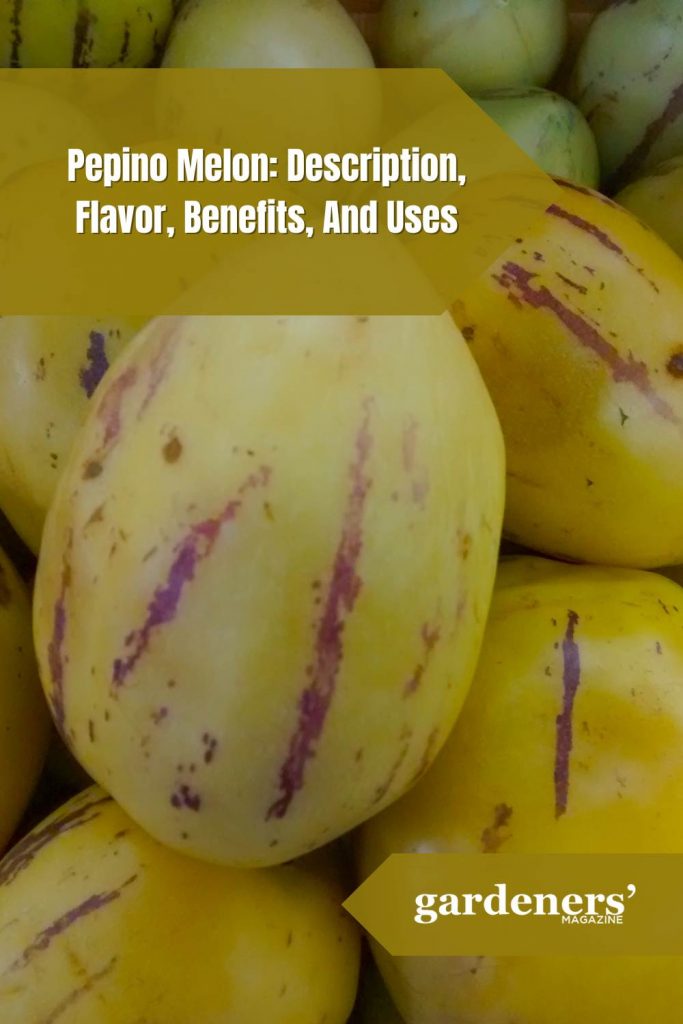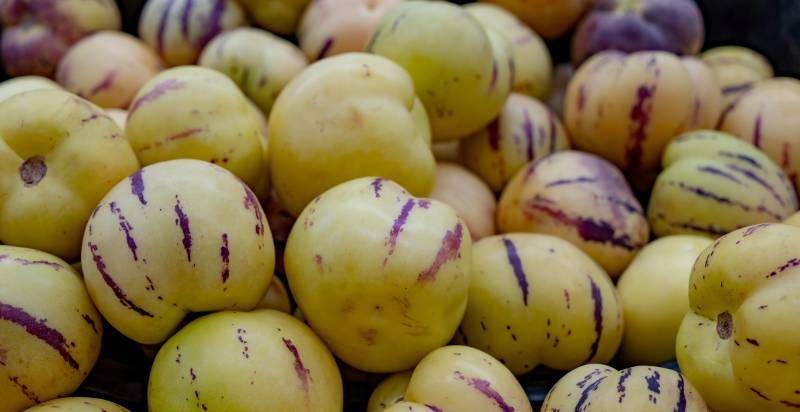Pepino Melon, also known as the tree melon, is a member of the Cucurbitaceae family and is related to cucumbers and melons. It’s believed that this unique fruit originated in either Peru or Argentina. The oval-shaped Pepino Melon has a yellowish-green exterior with white, yellow, or purple speckles and a sweet, juicy interior with a tropical flavor. Here is everything you need to know about the Pepino Melon, from its nutritional benefits to how it can be used in recipes.
What is Pepino Melon?
Pepino Melon is an exotic, pear-shaped melon native to the Andean highlands of South America. It has a mild sweet flavor and can be eaten fresh or used for cooking. The flesh of Pepino Melon is yellowish-white and contains small black seeds. The rind is thick, yellowish-green, and covered with small bumps. It is usually eaten fresh or used as a garnish for salads, desserts, and other dishes. The fruits are also processed into juices and jams.

History and Origin of Pepino Melon:
The pepino melon originates from South America. It is believed to have first been grown in the high Andean valleys of Chile, Peru, and Bolivia. Traditionally, it was a crop of small-scale farmers who cultivated this fruit as part of their subsistence farming activities. The popularity of the fruit has grown over time with the introduction of improved varieties and increased demand.
Today, pepino melons are grown throughout South America and other parts of the world, including Mexico, New Zealand, Australia, and Europe. In its native habitat, it is an important source of income for small-scale farmers. The fruit is becoming more widely available due to advances in cultivation methods and increased demand.
Growing Conditions of Pepino Melon:
Pepino melon requires warm soil and temperatures to grow successfully. It is best grown in full sunlight, where the temperature can reach up to 75°F or higher. This tropical plant prefers a well-draining, acidic soil with a pH of 5.5 – 6.8 and plenty of organic matter added for nutrition. Proper soil and temperature conditions are essential to keep the plant healthy and productive. When the soil starts to dry out, give it plenty of water, and add fertilizer regularly to encourage healthy development.
Pepino melons require a trellis or stake for support as they produce vines with fruit-bearing branches. When the fruit seems plump and is grown, it should be picked.Pepino melon plants can grow up to 8 feet tall and bear up to 4-5 melons per season under ideal conditions. Plants cultivated inside or in greenhouses must be kept out of direct sunlight and given enough air circulation to avoid mildew or other illnesses.
Health Benefits of Pepino Melon:
The vitamin C in pepino melon helps to strengthen our immune systems and keep us healthy. It also contains several minerals, including calcium, magnesium, potassium, and phosphorus, all of which are crucial for the metabolism and health of the bones.
Additionally, the fruit’s inherent sweetness aids in quelling sweet cravings without overindulging in sweets. Finally, Pepino melons are an excellent choice for anyone trying to lose additional weight because they are low in calories and fat.
Where are Pepino Melon Grown and Harvested?
Pepino melons are native to South America, primarily in Peru, Chile, and Bolivia. Pepinos grow best in warmer climates with plenty of suns. In the US, pepinos are mostly grown on the West Coast (in California and Oregon) and in Florida. Pepinos require a long growing season with temperatures between 60˚F and 85˚F and are usually harvested in the late summer to early fall. The fruit is prepared for harvest when it becomes yellowish-green and develops a fragrant perfume.

What Is The Flavor Profile Of The Pepino Melon?
The Pepino Melon has a sweet, refreshing flavor profile. Its taste is reminiscent of honeydew melons and cucumbers with juicy, slightly tart notes. It has a mild sweetness that can be further enhanced by adding sugar or other sweeteners. The texture of the flesh is soft and creamy, and its aroma is pleasantly fragrant.
Where can the Best Quality Pepino Melon be found?
The best quality Pepino Melon can be found in countries with a climate suitable for growing the fruit, such as Chile, Peru, and Costa Rica. The delicious melon is also widely available at specialty markets and grocery stores throughout the United States.
When shopping for Pepino Melons, look for those that are slightly soft to the touch and have a pleasant, sweet aroma. Avoid melons that appear pale or shriveled, and instead, select those that are fragrant and vibrant in color. Additionally, inspect for soft spots, bruises, or other signs of damage.
How do you Store Pepino Melon?
The best way to store Pepino Melon is to preserve it in the refrigerator, with a temperature of 34-40°F (1-4°C). It should be wrapped in plastic or paper to protect moisture and flavor. The fruit can last up to two weeks when stored properly. Alternatively, you can also freeze the melon for up to a year. Before freezing, it should be cut into small pieces and placed in an airtight container or bag. When ready to use the melon, thaw it overnight in the refrigerator.
How to Use Pepino Melon in Recipes?
Pepino melon is a unique and delicious fruit that can be used in a variety of recipes. It has a sweet, mild flavor and a crisp texture that makes it great for adding to salads, smoothies, or as an interesting topping on desserts.
One simple way to use pepino melon in your cooking is to combine it with other fruits and vegetables. For example, it can be diced and added to a fruit salad that includes apples, oranges, grapes or strawberries. It can also be used as a topping for yogurt or oatmeal dishes.
Pepino melon also goes great with other vegetables, like zucchini or bell peppers. It can be added to stir-fries and soups to add a sweet, juicy flavor. It can also be roasted with other vegetables like carrots or potatoes for an interesting side dish.
Try experimenting with this unique fruit and create something new! You may just end up creating a signature dish that everyone will love.
Conclusion:
Pepino Melon is a delicious and versatile fruit that can be enjoyed in many ways. From salads to smoothies to pies, Pepino Melon adds a sweet burst of flavor to any dish. Give it a try today and experience the flavor for yourself! With its mild taste and unique texture, you won’t be disappointed.
- Apricot Blossoms: Description, Flavor, Benefits, And Uses - April 23, 2024
- Everything you wanted to know about Green Tiger Tomatoes. - April 1, 2024
- Everything you wanted to know about Atomic Grape Tomatoes . - April 1, 2024

4 thoughts on “Pepino Melon: Description, Flavor, Benefits, And Uses”
Comments are closed.